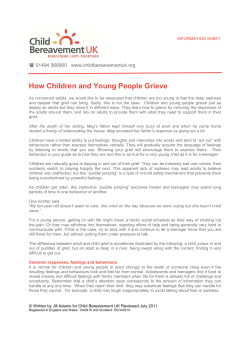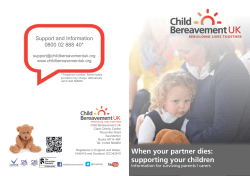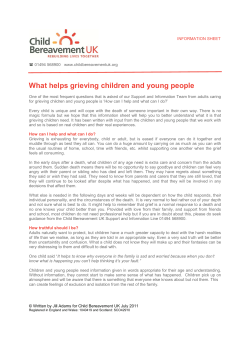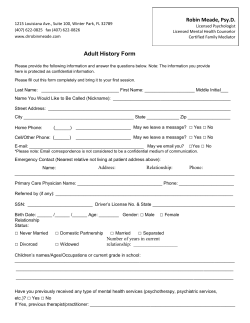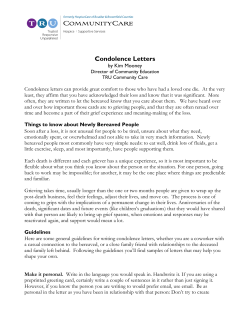
ing for griev ctivities
ving e i r g r s fo e i t i v i g act n i l a e een s t H & n e childr www.ryansheartnpo.org Just for ME! Healing activities for grieving children & teens A Production of Ryan’s Heart, A non-profit organization for grieving families. Many activities in the book are also used at other grieving centers and organizations across the country. All resources listed. All rights reserved. 2009 Ryan's Heart does not offer counseling. The organization exists only for support. Please do not use this booklet to give professional advice. The information provided herein is to be used for supportive purposes only and is not intended to replace the advice of any professional who may be caring for or assisting you. We strive to provide support, love and encouragement for parents and children as they begin to learn how to cope with the emotional effects a death can cause. 2 Dear Little Heart, Has someone you love recently died? Has that made you feel sad and angry? Does your heart hurt? Maybe you used to spend a lot time with that person, and now that you can’t, you miss them. Things must feel very different to you now. Although you can’t call that person or talk to them like you used too, you can still remember all of the wonderful things that you did together. Maybe you can even laugh about some of the silly pictures you took of each other. Remembering loved ones after they have died is important. All of us at Ryan’s Heart want you to know you are a very special little person and that being sad is OK. However, there are some things you can do to help you feel better. We created this book just for you. It is filled with games and activities that will help you think about your loved one and will eventually help your heart to not hurt so much. This book is all about you... Your feelings, your heart, and hopefully your smiles. To parents, caregivers, and friends, Please work through the activities in this book with your child. Talk to them about their feelings and let them explore. Remember, children must grieve too. Your child needs your presence, your love, your reassurance, and especially your hugs. ~ Blessings to all, The Ryan’s Heart Family 3 Table of Contents Children (ages 3-12) • • • Emotions—How are you feeling today? Understanding Emotions Physical Activities • Scream Box • Mad Box • Making Worry Beads • Fly like a Lion • Create a Family Flag • Create a Heart Break Pot • Kisses for Heaven • Bedtime Prayers • Play Fruit Ball • Draw a picture • Finish the Sentences Teens (ages 13-19) • • • • • Six Basic Principles of Teen Grief How should I grieve? The Bill of Rights for Grieving Teens 12 Helpful Hints for Your Personal Grief Journey Create a Support System Family Tree (all ages) Certificate of Completion (all ages) Resources 4 Young Children This section contains activities that are designed for children ages 3-12. Remember, all children grieve at different speeds, and process things differently. However all children need love, compassion and someone to help them to understand their feelings. 5 How are you feeling today??? The faces below show different examples of how you may be feeling right now. Which one best describes you? Parents: Have your child point the emotion picture that best shows how they are feeling today. Talk to them about why they feel this way. Explain that it’s ok to feel angry or sad, but encourage them talk about things that make them feel happy too. 6 Understanding emotions Discuss each emotion. Talk about things that make you feel each one. Then draw in the faces. 7 Physical Activities Make a Scream Box Equipment: Cereal box, paper towel tube, tape, paper, scissors 1. Stuff a cereal box with crumpled paper 2. Close the cereal box and cut a hole in the top for the paper towel tube. 3. Tape the paper towel tube to the hole in the cereal box. 4. Decorate the box however you want. 5. Scream into the box!!! Make a Mad Box Equipment: Box of any size, tape, paper 1. Fill box with paper. Cut pictures from a magazine or write down things that make you mad. 2. Tape the box shut. 3. Use a plastic bat or jump up and down on the box until it is destroyed. 4. Discard or recycle the remnants. 8 Make Worry Beads Equipment: Sculpting clay, toothpick, old cookie sheet 1. Roll clay into small balls. 2. Use the toothpick to put a hole through the center of the ball, making a bead. 3. Bake according to directions on the package. 4. String the beads after baking. Variation: Use molding clay or play-dough to mold and sculpt into different shapes. The feel of the clay can be soothing, helping to release anger, especially when children throw it onto a hard surface. Fly Like a Lion Equipment: Table, bean bags, gym mats or other soft surface, loud voices and supervision 1. Talk to your child about strength and power. Discuss people and animals who are powerful and what it means to them. 2. Help your child climb onto a table. 3. Let your child jump off the table onto the soft landing. Encourage him to jump powerfully (like a lion) and a use a loud powerful voice (or roar). 4. This is a great exercise for children to take back some of the power they may feel that they have lost during an illness or death, as well as a way to reach and express deep feelings. 9 Create a Family Flag Creating a family flag can represent your family’s grief journey. 1. Use fabric of choice and cut to desired size. 2. Hem and sew one seam along the edge for the flagpole to slide through. 3. Decorate and embellish as desired. Use small jewels or photos that remind your child of your loved one or your families journey through grief. 4. Proudly display your flag to encourage hope for the future and represent love for the past. Variation: Create a paper flag and use macaroni, stickers and strings for embellishments. Then proudly display on the fridge or on your child’s bedroom wall. Create a “Heart-Break” pot 1. Purchase small terra-cotta pots. Use one large pot for a family project or several small pots for each individual family member. 2. Carefully break (do not shatter) the pot(s). 3. Using paint pens and markers, have each family member or child write on the inside of the broken pieces. Instruct them to identify their feelings about being alone in their grief. On the outside of the pieces write about or draw their sources of support. 4. Work together to glue and piece the pot back together. This process incorporates the analogy that when a significant death occurs, ones heart breaks. A great family activity!!! 10 Kisses for Heaven A simplistic way for a child/adult to still send love. It is the physical touch that we miss so much and while nothing ever replaces that, we can do "physical" things to help process grief. Unwrap a chocolate Hershey kiss and allow the candy to melt in a special place (graveside/memorial site/garden ect.). This allows a child to feel that they are indeed sending kisses and love. It is also perfectly acceptable to eat the kisses, perhaps referring to the sweet taste as sweet kisses back. Be sure to remove the foil and discard appropriately. The heat, wind and rain will take care of the rest. Be sure to place upon the ground and not upon tables, chairs, and tombstones. Bedtime Prayers Matthew, Mark, Luke and John. Bless this bed he/she lays upon. Four corners to the bed. Four angels ‘round his/her head. One to watch, One to pray, And two to keep him/her Safe all day. Parents: After a death, children sometimes fear the dark or fear that they won’t wake up. To help calm their fears, you can use this comforting prayer as you tuck your children in at night. It’s simple, soothing lyrics can begin to ease anxieties and can help a young child to feel protected. 11 Play Fruit Ball Play Fruit Ball— a fun and simple game that allows children to smash fruit and vegetables as they are used in a game of baseball instead of using a baseball or softball. Using slightly spoiled items works best as they splatter more! Tomatoes, apples, oranges, bell peppers and potatoes all work great. It’s a little messy, but kids (and adults) love it. Draw a Picture Find a piece of paper and fold it in half. On one side of the paper draw a picture of your family before the death. On the other side of the paper draw a picture of your family after the death. Share it with someone who you feel would understand. Bonus: Have an adult scan your artwork and then email it to Ryan’s Heart at customerservice@ryansheartnpo.org and we will publish your drawing in our Little Hearts Albums. 12 Finish the Sentences... The thing that makes me feel the saddest is ..... If I could talk to the person who died I would ask (say)…. Since the death my family doesn’t…. My worst memory is…. If I could change things I would…. One thing that I liked to do with the person who died was… When the person died I…. Since the death my friends…. After the death, school…. When I am alone…. The thing that makes me feel the happiest is... The thing that makes me feel the safest is… The one person who understand me the most is… The thing that makes me feel the angriest is… I feel better when... 13 Teens This section is designed for teens, aged 13-19. As reported by the Dougy Center for Grieving Children and Families, teens respond better to adults who choose to be companions on the grief journey rather than direct it. They have also discovered that adult companions need to be aware of their own grief issues and journeys because their experiences and beliefs impact the way they relate to teens. 14 Six Basic Principles of Teen Grief For parents, caregivers, friends and guardians: 1. Grieving is the teen’s natural reaction to a death. Grief is a natural reaction to death and other losses. However, grieving does not feel natural because it may be difficult to control the emotions, thoughts, or physical feelings associated with a death. The sense of being out of control that is often a part of grief may overwhelm or frighten some teens. Grieving is normal and healthy, yet may be an experience teens resist and reject. Helping teens accept the reality that they are grievers allows them to do their grief work and to progress in their grief journey. 2. Each teen’s grieving experience is unique. Grieving is a different experience for each person. Teens grieve for different lengths of time and express a wide spectrum of emotions. Grief is best understood as a process in which bodily sensations, emotions, thoughts, and behaviors surface in response to the death, its circumstances, the past relationship with the deceased and the realization of the future without the person. For example, sadness and crying may be an expression of grief for one teen, while another may respond with humor and laughter. 3. There are no “right” and “wrong” ways to grieve. Sometimes adults express strong opinions about “right” or “wrong” ways to grieve. But there is no correct way to grieve. Coping with a death does not follow a simple pattern or set of rules nor is it a course to be evaluated or graded. 4. Every death is unique and is experienced differently. The way teens grieve differs according to personality and the particular relationship they had with the deceased. They typically react in different ways to the death of a parent, sibling, grandparent, child, or friend. For many teens, peer relationships are primary. The death or loss of a boyfriend or girlfriend may seem to affect them more than the death of a sibling or grandparent. 15 5. The grieving process is influenced by many issues. The impact of a death on a teen relates to a combination of factors including: • Social support systems available for the teen (family, friends and/or community) • Circumstances of the death - how, where and when the person died • Whether or not the young person unexpectedly found the body • The nature of the relationship with the person who died harmonious, abusive, conflictual, unfinished, communicative • The teen’s level of involvement in the dying process • The emotional and developmental age of the teen • The teen’s previous experiences with death. 6. Grief is ongoing. Grief never ends, but it does change in character and intensity. Many grievers have compared their grieving to the constantly shifting tides of the ocean; ranging from calm, low tides to raging high tides that change with the seasons and the years. These principles were developed by the Dougy Center and are the result of many years of experience working with teens and grief. 16 How should I grieve? Grief is different for everyone. Your feelings may change from day to day or even from minute to minute. Below are some common ways that teens tend to grieve. We have intentionally left some blank lines for you to write in how YOU are grieving. • • • • • Crying. Tears are healthy, not childish. Talk about it. Confide in an adult that you are comfortable with. Write about death, your experience with death and how it has made you feel. Keep a journal or a notebook. Express your feelings in creative ways. Draw pictures. Paint. Build. Scrapbook. Exercise. Physical activity helps release anger and sad emotions. Play sports. Dance. Join a gym. Today I….. 17 The Bill of Rights for Grieving Teens Developed by grieving teens and shared by the Dougy Center for Grieving Children and Families. A grieving teen has the right…. • • • • • • • • • • • • • • • to know the truth about the death, the deceased, and the circumstances. to have questions answered honestly. to be heard with dignity and respect. to be silent and not tell you her/his grief emotions and thoughts. to not agree with your perceptions and conclusions to see the person who died and the place of the death. to grieve any way she/he wants without hurting self or others. to feel all the feelings and to think all the thoughts of his/her own unique grief. to not have to follow the “Stages of Grief” as outlined in a high school health book. to grieve in one’s own unique, individual way without censorship. to be angry at death, at the person who died, at God, at self, and at others. to have his/her own theological and philosophical beliefs about life and death. to be involved in the decisions about the rituals related to the death. to not be taken advantage of in this vulnerable mourning condition and circumstances. to have guilt about how he/she could have intervened to stop the death. 18 12 Helpful Hints for Your Personal Grief Journey Grief is exhausting. It takes a lot of time and energy and can wear you out. That is why anyone who is going through grief needs love, understanding and encouragement. Grief is a journey and no two journey’s are alike. However, here are some helpful hints that you can use along the way. 1. Eat healthy foods and snacks. A healthy diet will keep your physical body in good health and will promote a better well being. 2. Get lots of rest. Take naps—remember grieving takes a lot of work. 3. Talk about your feelings. Find someone you feel comfortable sharing your thoughts and emotions with. 4. Exercise. Physical activity will help to release negative energy. 5. Laugh often. Laughing, even when you are sad or angry is healthy. In fact, it’s nature’s own best medicine. 6. Spend time with friends. 7. Write down your feelings. Keep a diary or a journal. 8. Draw pictures or paint. Art is a fantastic way to express yourself! Share it with others. 9. Start a book of memories or make a memory box, powerpoint or video. Be creative. Scrapbook or journal. Include special pictures and thoughts. When you are finished you will have a very special keepsake all about you and the person who died. Refer to it often. It will make you smile. 10. Don’t rush grief. It takes it’s own time. You do not “get over” grief. In time however, you will accept things intellectually and will learn how to go on. 11. Write a letter to God, or a counselor or to the person who died. Tell them how you feel, what makes you angry or sad. It will make you feel better, even if you don’t send it. 12. Join a support group or workshop. Being with other teens who have experienced a loss is comforting. 19 Create a Grief Support System 1. Find three people you are comfortable talking to. 2. Name a place that you can go that is comfortable and safe. 3. Name three things you can do, or three people you can be with, where you can let out anger without hurting yourself or others. 4. Name three things you can do or three people you can be with to let out sad feelings. 5. Name three non-harmful ways to release feelings of anger or sadness. 6. Name three things you can do when life feels meaningless. 7. Name three activities you can do that will help you to express your feelings. Examples: writing, drawing, hitting pillows, singing, playing sports, dance. 8. Name some things that will help you get your mind off your loss. 20 A Family Tree My Father’s Parents Their child (and spouse) Their child (and spouse) My Mother’s Parents Their child (and My Parents My Brother or Sister (and spouse) My Brother or Sister (and spouse) Their child (and Their child (and spouse) Their child (and spouse) Their child (and My Brother or Sister (and spouse) My Child (and spouse) Their child (and spouse) My Brother or Sister (and spouse) ME (and spouse) Their child (and spouse) Their child (and spouse) Their child (and spouse) My Child (and spouse) Their child (and spouse) My Child (and spouse) Their child (and spouse) Their child (and spouse) Their child (and My Child (and spouse) Their child (and spouse) Their child (and spouse) Their child (and spouse) Their child (and spouse) Their child (and spouse) 21 Certificate of Completion! Ryan’s Heart proudly acknowledges that: Has read and accomplished many of the activities in Just for Me! and is working very hard on their own personal grief journey. We are proud of you!!! Keep up the good work! 22 Resources Ryan’s Heart has researched, collected and included activities in this booklet that we feel will be especially helpful to children and teens as they begin to process grief. The following organizations and grief centers were used as key reference guides in developing this booklet. Many of the ideas and activities are also used and shared at their facilities and websites, and therefore are given credit for the ideas. This book is intended to give parents, teens and children a quick reference guide and to be used as a beginning took kit as you begin traveling grief’s journey. We encourage you to visit the references and their websites below for more information on grief. Ryan’s Heart—a non-profit organization for grieving families Presque Isle, ME www.ryansheartnpo.org The Dougy Center for grieving children and families Portland, OR www.dougy.org The Healing Place—a center for loss and change Tuscumbia, AL www.thehealingplacinfo.org Hospice Foundation of America Washington, DC www.hospicefoundation.org The Center for Grieving Children of Maine Portland, ME www.cgcmaine.org 23
© Copyright 2025

